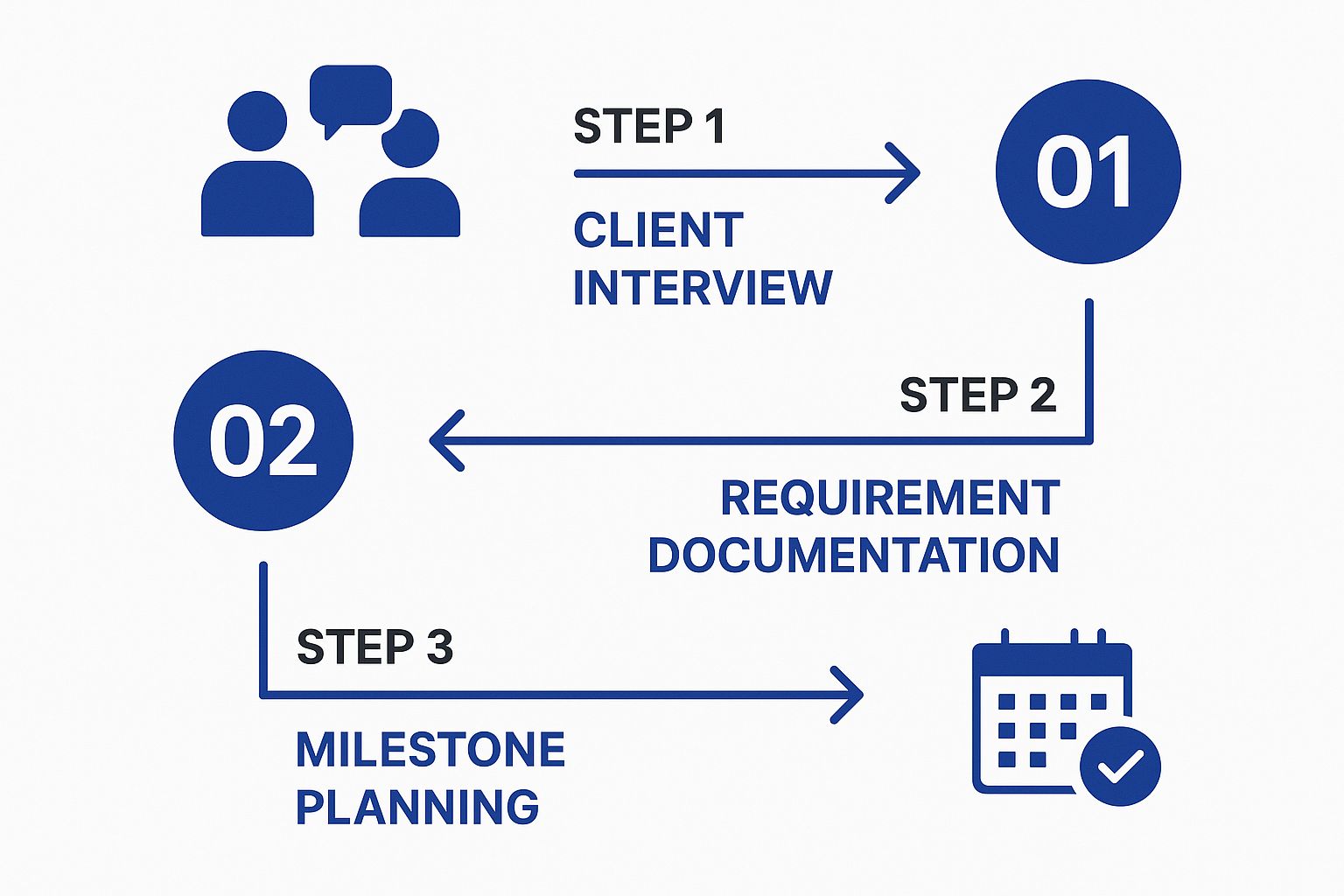When you hear "project management for web design," what comes to mind? If it’s just a fancy term for a to-do list, you're missing the bigger picture. Real project management is the backbone that keeps a web design project from spiraling into chaos. It’s the structured approach to planning, executing, and ultimately delivering a website that works—on time and on budget.
Without a solid framework, you're just reacting. Client expectations, creative feedback, technical hurdles, and the final launch all become a disorganized scramble. A good system provides a clear path through the noise.
Why Old-School Project Management Breaks Web Design
Let's be honest: a lot of web design projects feel like a constant battle. Scope creep is relentless, feedback loops are endless, and communication breakdowns are practically a daily occurrence. The surprising culprit? Often, it's the project management method itself.
Traditional, rigid methods—the kind you’d use to build a bridge or manufacture a car—are simply not cut out for the fluid, creative, and highly collaborative world of web design. They often make things worse, not better.
A web design project isn't an assembly line. It’s a dynamic process that has to balance artistic vision with technical realities, all while navigating the notoriously subjective world of client feedback. Trying to force that into an inflexible, old-school plan is like trying to fit a square peg in a round hole. It just suffocates the process.
The Friction Between Creativity and Rigidity
The heart of the problem is that web design is fundamentally iterative. A brilliant idea for a user interaction might only pop up after seeing a prototype. A technical roadblock might force a creative pivot. Rigid, waterfall-style plans leave zero room for this kind of essential adaptation.
Imagine your designer is forced to stick to a wireframe that was approved weeks ago, even though user testing just revealed a massive flaw in the navigation. The result? You deliver a website on schedule, but it provides a terrible user experience. This is precisely where old-school methods fall flat.
Key Takeaway: Forcing a creative process into a rigid, linear box is a recipe for frustration and a subpar product. Great project management for web design has to embrace change, not fight it.
This disconnect explains why so many digital projects go off the rails. The data tells a stark story. While 77% of high-performing projects rely on dedicated software, a staggering 23% of organizations have actually adopted these tools. This inefficiency is costly, with poor project performance wasting an average of 11.4% of every dollar invested. You can dig into more revealing project management stats to see just how widespread these challenges are.
Common Pain Points in Web Design Projects
When you use the wrong approach, a few predictable problems rear their ugly heads. Agencies and freelancers know these all too well. They aren't just minor headaches; they're project-killers that can tank profitability and destroy client trust.
- Uncontrolled Scope Creep: It always starts with "just one more little change." Before you know it, that small request has snowballed into weeks of unpaid work, blowing up the budget and timeline.
- Vague and Conflicting Feedback: You get a storm of contradictory notes from different people through email, Slack, and even text messages. It’s impossible to know which direction to go.
- Designer-Developer Handoff Disasters: Designs get tossed "over the wall" to developers without the right context or technical specs, leading to massive misinterpretations and costly rework.
- Lost Momentum and Team Burnout: With no clear priorities or visible progress, the team gets demoralized. The project grinds to a halt under the weight of confusion and endless revisions.
These issues are symptoms of a management style that prioritizes a fixed plan over collaborative problem-solving. This is why we need to rethink how we manage these projects from the ground up.
The following table breaks down these all-too-common issues and contrasts them with the modern solutions that are built to handle the unique demands of web design.
Common Project Pitfalls vs Modern Solutions
| Common Pitfall | Impact on Web Design Project | Effective PM Solution |
|---|---|---|
| Scope Creep | Unplanned work leads to blown budgets, missed deadlines, and team burnout. | Use a centralized platform like BugSmash to track all requests. Implement a formal change request process to evaluate impact before approval. |
| Disorganized Feedback | Contradictory notes from multiple sources create confusion and endless revision cycles. | Consolidate all feedback into a single visual collaboration tool. Require stakeholders to review and approve feedback in one place. |
| Poor Handoffs | Developers receive incomplete designs, causing delays and forcing them to make assumptions. | Create a "single source of truth" with detailed design specs, assets, and annotations that both designers and developers can access. |
| Lack of Visibility | The team and client can't see progress, leading to a loss of momentum and trust. | Adopt an Agile or iterative methodology with visual project boards (Kanban) to make progress transparent for everyone involved. |
| Rigid Planning | Inability to adapt to new ideas or technical challenges stifles creativity and results in a weaker final product. | Build flexibility into the project plan with sprints and iterative reviews, allowing for adaptation and improvement throughout the process. |
In short, these modern solutions are about creating a system built for flexibility, clear communication, and proactive adaptation. It’s about building a structure that guides the creative process without putting it in a straitjacket. A modern approach to project management for web design is not just a nice-to-have; it's essential for survival.
The Strategic Discovery and Planning Blueprint
A web design project is won or lost long before the first pixel is ever placed. The real foundation for success gets built during the strategic discovery and planning phase. This goes way beyond just sketching out a sitemap; it's about digging deep to understand the why behind the project.
Honestly, this initial stage sets the entire trajectory. I’ve seen it time and time again: a rushed or superficial planning process is the number one cause of scope creep, blown budgets, and friction with the client down the road. Investing time here isn't a luxury—it’s an absolute must for delivering a website that actually makes an impact.
Running a Purposeful Kickoff Meeting
The project kickoff isn’t just a meet-and-greet. It's your single best chance to get every stakeholder on the same page, uncover hidden assumptions, and define what "success" actually looks like in real, concrete terms. The goal is to move from vague ideas like "a modern look" to specific, measurable business objectives.
To get there, you have to ask the right questions. Move past the surface level and probe deeper to get at the core motivations and expectations.
- Business Goals: "Looking beyond just a new website, what specific business outcome are you hoping to achieve in the next 12 months? Are we talking about increasing leads by 20%? Or maybe reducing support calls?"
- Target Audience: "Can you describe your ideal customer in detail? What are their biggest pain points that this new website absolutely has to solve?"
- Competitive Landscape: "Which competitors' websites do you admire, and what do you like about them? More importantly, where do you see an opening for your site to do something better?"
- Success Metrics: "Six months after we launch, how will we know this project was a success? What specific Key Performance Indicators (KPIs) should we be tracking?"
Asking questions at this level helps you build out accurate user personas and map out user journeys that feel intuitive because they solve real problems, not just perceived ones.
Crafting the Comprehensive Project Brief
All those great insights from your kickoff meeting need to be captured in a rock-solid project brief. Think of this document as your North Star—a single source of truth that guides every single decision. It needs to be detailed, clear, and signed off on by everyone before any design work kicks off.
A well-crafted project brief is the ultimate defense against scope creep. It transforms subjective opinions into objective criteria, ensuring that every design and development decision is tied back to a clearly stated goal.
Your brief should crystallize everything from the discovery phase into a formal plan. For a deeper dive into what this entails, you might find value in our complete project management playbook for website development. It provides a structured approach to ensure nothing gets missed.
The process-flow infographic below illustrates the core sequence, from that first client contact to structured planning.

This visual really hammers home the point that diligent documentation is the crucial bridge between understanding a client's needs and creating a plan you can actually execute.
Choosing the Right Methodology
Finally, your planning blueprint has to define how you're going to work. The methodology you pick has a huge impact on the project's flow, flexibility, and communication rhythm. There's no one-size-fits-all answer here.
Common Methodologies for Web Design:
- Waterfall: This is the traditional, linear approach where each phase (e.g., discovery, design, development, testing) has to be finished before the next one starts. It’s best for small, simple projects where the requirements are set in stone and won't change.
- Agile: This is an iterative approach that breaks the project into small, manageable "sprints." It's fantastic for complex projects where requirements might evolve, as it allows for constant feedback and adaptation.
- Hybrid: This approach often gives you the best of both worlds. It uses a Waterfall-style process for the initial discovery and planning to set a firm foundation, then switches to Agile sprints for design and development to stay flexible.
Choosing wisely means matching the project's complexity and the client's personality to the right workflow. Once you have this clear blueprint in hand, exploring a comprehensive guide on creating a business website can give you even more valuable insights into the entire development lifecycle, helping to sharpen your strategic planning.
Bringing the Vision to Life with Clarity and Collaboration

Alright, the planning is done. Now for the exciting part—turning those brilliant concepts and wireframes into a real, functional website. This is where the magic happens, filled with design sprints, coding sessions, and a whole lot of back-and-forth.
The real challenge here is keeping the project moving forward without cutting corners on quality. It’s a tightrope walk between structured project management and giving your team the creative space they need. If everyone, including the client, isn't on the same page, even the most meticulous plan can spiral into confusion and expensive do-overs.
Structuring Feedback to Avoid Chaos
Let’s be honest: vague client feedback is a project’s worst enemy. Comments like "I don't like it" or the dreaded "make it pop" are pure chaos. Your job is to steer the client toward feedback that's objective and, most importantly, actionable.
A technique I’ve found invaluable is to frame feedback rounds around specific, strategic goals. Instead of a wide-open "what do you think?", try asking, "Does this layout clearly guide users to the 'request a demo' button?" This shifts the conversation from subjective taste to measurable effectiveness.
Pro Tip: Stop accepting feedback from scattered emails and random Slack DMs. It’s a recipe for disaster. Insist on a single source of truth—like a visual annotation tool—where every comment is tied directly to the design element it refers to. This clears up ambiguity and stops contradictory notes in their tracks.
This approach doesn't just get you better feedback; it respects your team's time by shutting down those endless, aimless revision cycles.
The Designer-to-Developer Handoff
The moment a design moves to development is where a lot of great projects hit a wall. A stunning design is worthless if it's a nightmare to build or if the developer has no idea how the interactive elements are supposed to work. Nailing this handoff is a core part of effective project management for web design.
To avoid this all-too-common pitfall, put together a comprehensive handoff kit. This isn’t just about sending a file; it’s about providing a complete blueprint. It should include:
- Finalized Mockups: High-fidelity designs for every key page and user state (like hover effects or form error messages).
- A Living Style Guide: Clear specs for typography, color palettes, spacing, and grid systems.
- An Organized Asset Library: All icons, images, and fonts, properly exported and named.
- Interaction Notes: Simple, clear explanations for any animations or complex user flows.
This turns the handoff from a file drop into a collaborative checkpoint. Get your designer and developer in a room (virtual or physical) to walk through the kit together. This is the time to ask questions and iron out any wrinkles before a single line of code gets written.
Fostering Real-Time Collaboration
Modern web projects are built on a foundation of constant communication. Your project management tool should be the central hub for the entire operation, keeping everyone perfectly in sync. I’m a big fan of platforms that bundle task management, version control, and real-time chat into one place.
And don't keep this process hidden from your client. Giving them read-only access to a project board (like a simple Kanban board) is a great way to manage their expectations. It builds trust by making them feel like an active part of the team.
The need for this kind of structured management is why the global project portfolio management market, valued at around $6.13 billion, is set to grow at a CAGR of 13.0% through 2030. Poor execution is costly—nearly 10% of every project dollar is wasted because of it.
Ultimately, strong communication is what fuels successful collaboration. For more tips, check out our guide on improving team communication strategies for better productivity. It’s all about creating an environment where information flows freely, breaking down silos and giving everyone the context they need to do their best work.
Nail Your Launch With Rigorous Testing

Getting a project across the finish line is one thing. Launching a polished, high-performing website that just works? That’s what separates the pros from the amateurs in project management for web design. This is where your diligence really pays off, turning a "nearly there" site into something you're proud to show the world.
It all comes down to structured, methodical testing.
The goal isn’t just about squashing bugs. It's about making sure every button, link, and form actually delivers on the strategic goals you set way back in the discovery phase. A sloppy launch can torpedo months of incredible work in an instant.
Build a Real-World Quality Assurance Checklist
First things first: you need a solid quality assurance (QA) checklist. This isn’t a quick once-over; it’s a systematic review of the entire site that prevents critical details from slipping through the cracks. It also gets everyone on the same page.
Break your checklist down into logical chunks:
- Functionality: Do all the links go to the right place? Do forms actually submit data? Do interactive elements work as promised?
- Cross-Browser & Device Compatibility: How does it look on Chrome, Firefox, Safari, and Edge? More importantly, is the mobile experience on iOS and Android genuinely intuitive or just a shrunken-down version of the desktop site?
- Performance: How fast do pages load? Are the images optimized for the web? Running the site through Google's PageSpeed Insights is non-negotiable.
- Content & SEO: Is all the "lorem ipsum" placeholder text gone? Are the meta titles and descriptions in place? Does the sitemap exist?
This simple shift moves testing from a chaotic free-for-all to a managed, measurable process.
Crush Bugs With Smarter Tracking
As your team dives in, you're going to find issues. That’s the point. The real challenge is managing all that feedback without getting buried in confusing email chains or messy spreadsheets. This is where a dedicated bug-tracking tool is a lifesaver.
Forget vague notes like "the button is broken." A tool like BugSmash lets a tester pinpoint an issue directly on the webpage, and the developer can see the exact element, browser, and comment all in one place.
Key Insight: The real magic of a bug tracker is turning a flood of feedback into an organized, actionable list. It centralizes everything. The project manager can see every open ticket, assign it to the right person, and watch its status until every last bug is squashed.
This visual context is a game-changer. It cuts out the endless back-and-forth and saves a ton of developer frustration.
Navigate User Acceptance Testing Like a Pro
Once you’ve finished your internal QA, it's time for User Acceptance Testing (UAT). This is where you hand the keys over to the client for their final review. The trick here is to guide them toward giving helpful, constructive feedback, not last-minute creative whims.
Set clear expectations from the start. Explain that UAT is for finding bugs and confirming the site meets the agreed-upon requirements—it's not the time for a redesign. To keep them on track, provide a simple checklist or a few user scenarios to test, like "Try to purchase a product" or "Find the contact page and send a message." This focused approach is critical. Learning how to get website design feedback effectively can completely transform this stage from a headache into a productive partnership.
Your Final Pre-Launch Sanity Check
With UAT done and the last bugs squashed, you're on the home stretch. But before you hit that big red "launch" button, run through one final pre-launch checklist. It's your last line of defense. As you get close to the end, using a robust pre-launch checklist can mean the difference between a smooth deployment and a frantic scramble.
Make sure your own list covers these essentials:
- Final SEO Checks: Is the live sitemap submitted? Is the robots.txt file configured correctly?
- Analytics Setup: Double-check that Google Analytics or your preferred tracking tool is installed and actually recording data.
- Security Scans: Run one last scan for any vulnerabilities.
- Backup Strategy: Confirm that automated backups are scheduled and working.
This final check ensures your launch feels less like a panic and more like a well-deserved celebration.
Building Your Modern Web Design Project Management Toolkit
Your tools don't define your process, but they can absolutely make or break it. The right technology stack is a force multiplier, cutting through the noise of communication and bringing much-needed clarity to complex projects. The wrong one? It’s just another monthly subscription and a fresh layer of confusion.
I've seen it time and time again: successful project management for web design isn't about having the most tools, but having the right ones. It's about moving past generic "top 10" lists and thinking critically about how your team actually gets work done. Are you a solo freelancer juggling a handful of clients, or a distributed agency team wrangling enterprise-level builds? Your answer changes everything.
Core Project Management Platforms
Every good toolkit needs a command center—your primary project management platform. This is where you’ll manage tasks, map out timelines, and keep a pulse on progress. Getting this choice right is crucial.
- Asana and Monday.com are fantastic all-rounders. Their visual timelines, handy automations, and multiple project views are perfect for agencies that need to manage both client work and internal operations under one roof.
- Trello is the champion of simplicity. Its drag-and-drop Kanban board is a perfect entry point for freelancers or small teams who crave a visual, intuitive way to track tasks without a steep learning curve.
- Jira is the undisputed heavyweight for development-intensive projects. If your work involves tricky back-end integrations or rigorous bug-tracking sprints, Jira’s deep feature set is hard to beat.
For teams looking to truly connect the dots, a HubSpot Jira integration can be a game-changer. It bridges the all-too-common gap between sales promises and development realities, creating a seamless flow of information from customer interaction to coding.
Essential Supporting Tools
No single platform can do it all. The best toolkits I've seen integrate specialized apps that excel at one specific part of the web design process. Your stack isn't complete without them.
Key Insight: The real goal is to create a "single source of truth" for each phase of a project. Centralize team chat in one place, design collaboration in another, and QA in a third. This is how you stop vital information from getting buried in endless email threads or competing Slack channels.
Think of it as building a specialized ecosystem:
- Communication: Slack remains the gold standard for real-time team chat. Creating dedicated channels for each project keeps conversations focused and easy to find later.
- Design Collaboration: Figma has rightfully become the industry benchmark. It allows designers, developers, and clients to collaborate on mockups and prototypes in real time, with comments tied directly to the visuals. No more "can you move that thing on the left?" emails.
- File Management: Google Drive offers a simple, universally accessible hub for every project document—from the initial brief to final brand assets. It ensures everyone is working from the latest version.
- Quality Assurance: BugSmash is a lifesaver for the QA phase. It replaces messy spreadsheets and endless email chains, letting clients and testers report issues with pinpoint accuracy directly on the webpage. This makes feedback fast, clear, and immediately actionable for developers.
Picking the right tech isn't just an operational choice anymore—it's a strategic one. The project management software market is exploding, projected to hit $10 billion by 2026. This boom is a direct response to the rising complexity of digital projects and a growing talent gap, with an estimated 2.3 million new project management roles needing to be filled each year. Investing wisely in your toolkit gives you a serious competitive edge.
Top Project Management Tools for Web Design Teams
Choosing the right project management software can feel overwhelming. To help, here’s a quick comparison of some popular options, highlighting what they do best for web design projects.
| Tool | Best For | Key Feature for Web Design | Pricing Model |
|---|---|---|---|
| Asana | Agencies managing multiple client projects | Visual timelines and workload management | Freemium, with paid tiers for more features |
| Monday.com | Teams needing high-level dashboards and reporting | Customizable dashboards for project overviews | Tiered subscriptions, no free plan |
| Trello | Freelancers and small teams who love simplicity | Intuitive Kanban boards for visual task tracking | Freemium, with affordable "Business Class" |
| Jira | Development-heavy web projects | Advanced bug tracking and agile sprint planning | Freemium for up to 10 users |
Ultimately, the best tool is the one your team will actually use. Consider your team's size, the complexity of your projects, and your budget to find the perfect fit.
Answering Your Web Design Project Management Questions

Even with the best plans in place, web design projects have a knack for throwing curveballs. The real mark of an experienced project manager isn't just following a plan—it's how you handle the unexpected. This is where the real work begins.
I've gathered some of the most common questions I hear from other PMs and agency owners. Think of this as the advice I wish I had when I was knee-deep in a tricky project. It's all about navigating those tough spots, tightening up your agency's process, and ultimately building stronger client relationships.
How Do You Effectively Manage Scope Creep With Demanding Clients?
Let's be real: scope creep is a constant battle. The key isn't just learning to say "no," but managing expectations from the very first conversation. A rock-solid discovery phase is your first line of defense. Get everything in writing—every feature, every deliverable, and even the exact number of revision rounds. This has to be crystal-clear in your contract.
When a client inevitably asks for "just one more thing," don't shut them down. Acknowledge it as a great idea. I like to frame it as a perfect addition for "Phase 2" or a "future enhancement." Then, you immediately follow up with a clear, separate quote for the time and cost. Suddenly, a potential conflict becomes a new business opportunity.
Make sure you document every single one of these requests in your project management tool. This creates a transparent paper trail that protects your timeline and budget. Regular status meetings are also your secret weapon for gently reminding everyone what's in scope for the current milestone, keeping the project on track.
What Is the Best Project Management Methodology for Web Design?
There's no magic bullet here. The "best" methodology really depends on the project's complexity and the client's needs. A classic Waterfall approach, where you complete one phase before starting the next, might work for a tiny, straightforward website where the requirements are set in stone. But let’s be honest, that’s incredibly rare.
Most web design projects thrive under an Agile or Hybrid model.
- Agile: This is my go-to for complex projects. Working in iterative sprints allows for constant feedback and adaptation, which is a much more natural fit for creative work. It expects requirements to evolve.
- Hybrid: This is often the sweet spot. You can use a Waterfall approach for the initial discovery and strategy to lock in a solid foundation and budget. Then, you shift to Agile sprints for the actual design and development, giving your team the flexibility it needs to be creative and responsive.
This blended approach gives you the best of both worlds: the upfront structure for confident planning and the adaptability needed for brilliant execution.
How Can I Improve Communication Between All Parties?
Stop the madness of scattered emails, random texts, and Slack DMs. This is where things get lost, misinterpreted, and delayed. You need to centralize all project communication.
Your project management platform should be the single source of truth. All formal feedback, task assignments, approvals, and questions should live there. This ensures nothing gets lost and everyone has access to the same information.
For quick, daily check-ins with your internal team, a dedicated Slack or Teams channel is perfect. For clients, I swear by a recurring weekly or bi-weekly call. Use that time to present progress, get their consolidated feedback, and set expectations for the next week. And when it comes to QA, using a visual tool like BugSmash is a lifesaver. It lets clients and your team pin comments directly onto design elements, so there’s zero guesswork for your developers.
What Are the Most Critical KPIs to Track?
While every project is different, there are a few Key Performance Indicators (KPIs) that are non-negotiable for gauging the health of any web design project. You need a mix of project management metrics and post-launch performance stats.
Here's what I always keep a close eye on:
- Budget vs. Actuals: The most straightforward financial health check. Are you making money or losing it?
- Schedule Variance: This tells you instantly if you're on track, ahead of schedule, or falling behind.
- Number of Revisions: If this number starts creeping up, it’s a red flag. It often points to unclear requirements or a hesitant client.
- Client Satisfaction: A simple survey after a major milestone can give you priceless insights into the client's experience.
- Post-Launch Metrics: The project isn't over when the site goes live. You need to track things like Page Load Speed, Conversion Rate, and Time on Page to prove your work delivered real results.
Tired of chasing feedback through messy emails and spreadsheets? BugSmash provides a centralized, visual platform to collect actionable feedback on websites, images, and PDFs, cutting your review time in half. Streamline your QA process and launch flawless projects faster. Start for free on bugsmash.io and see the difference.




